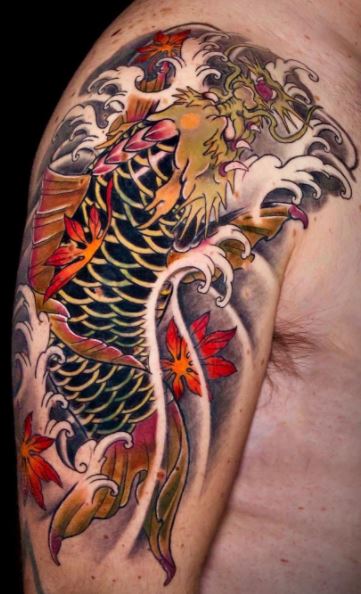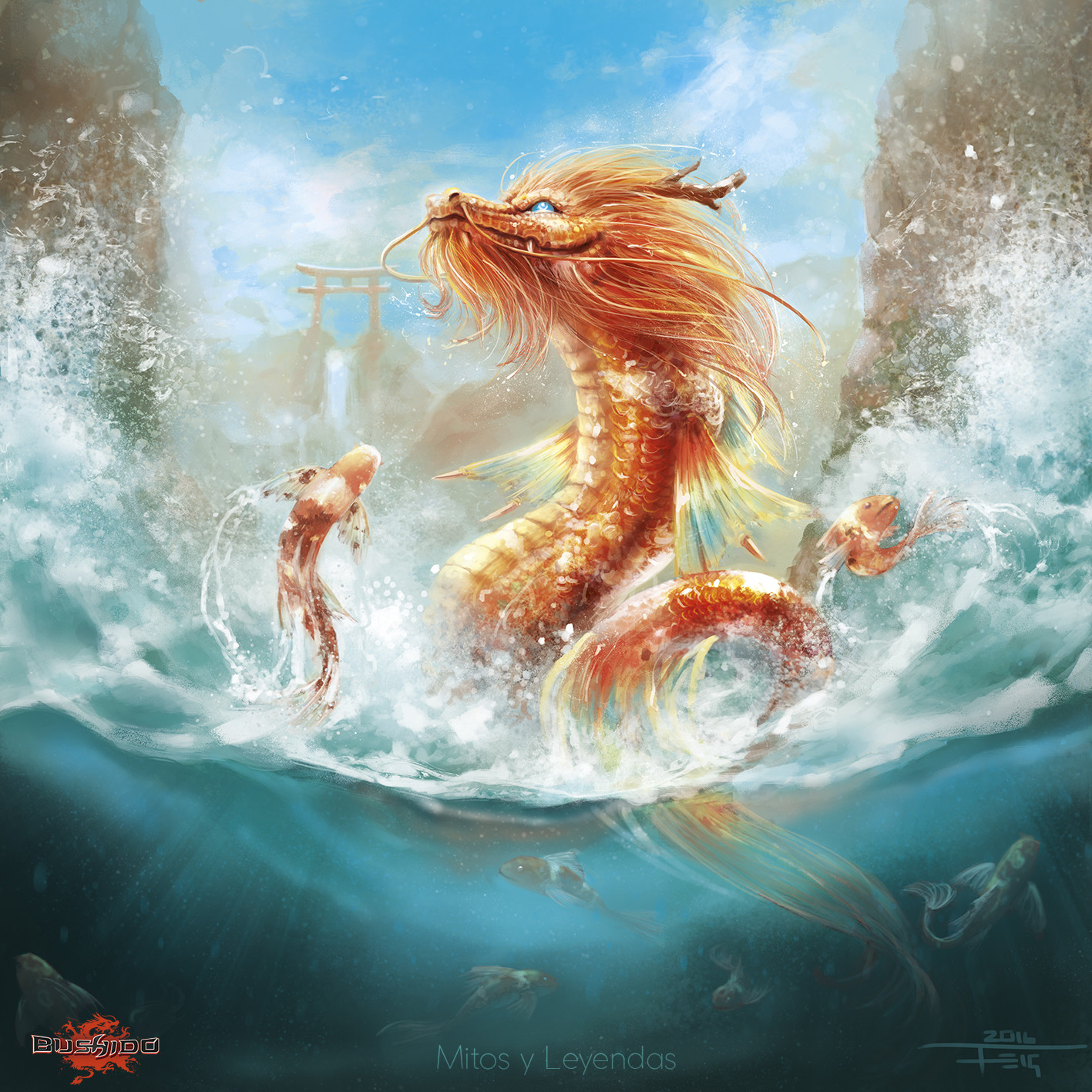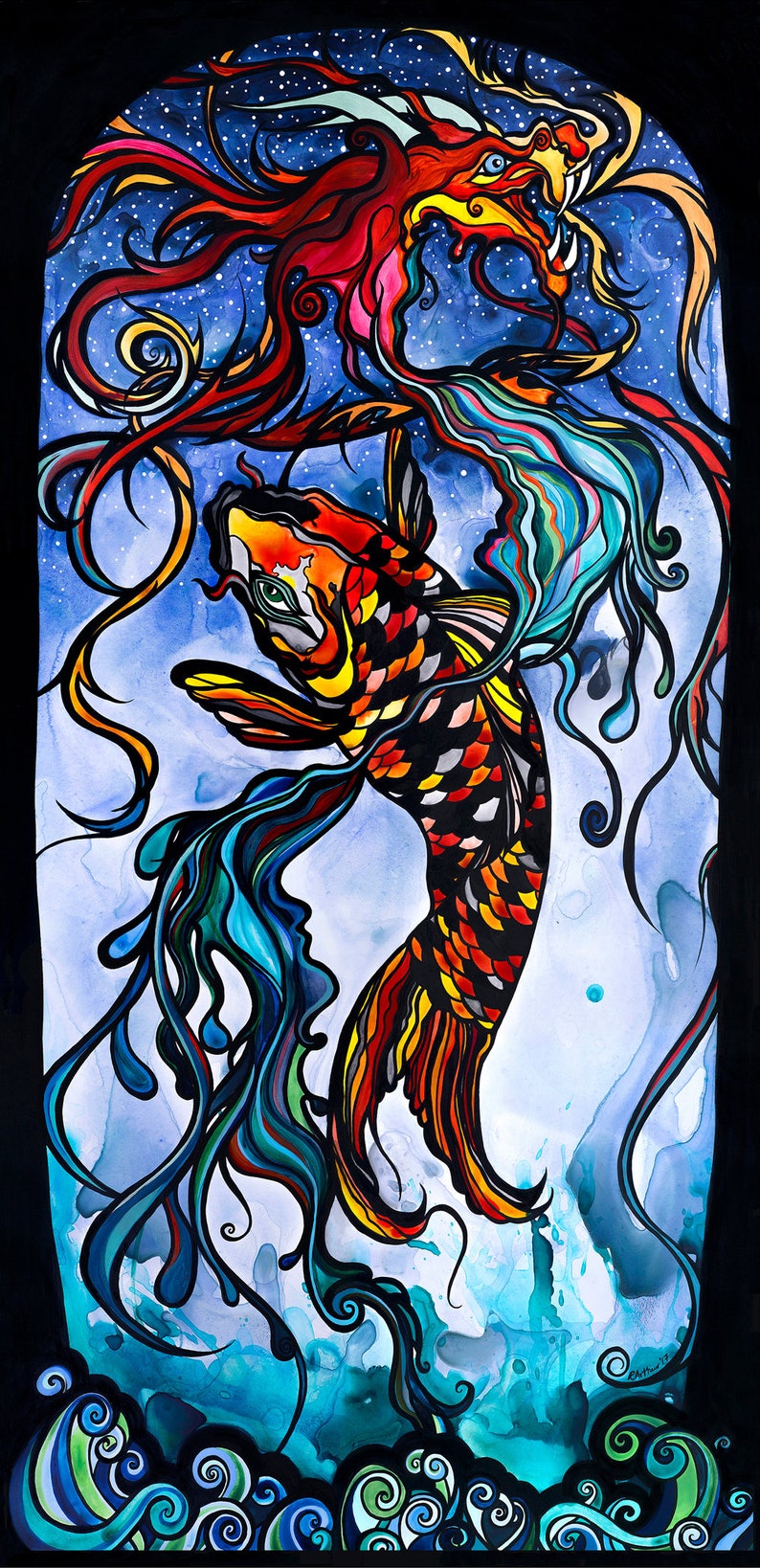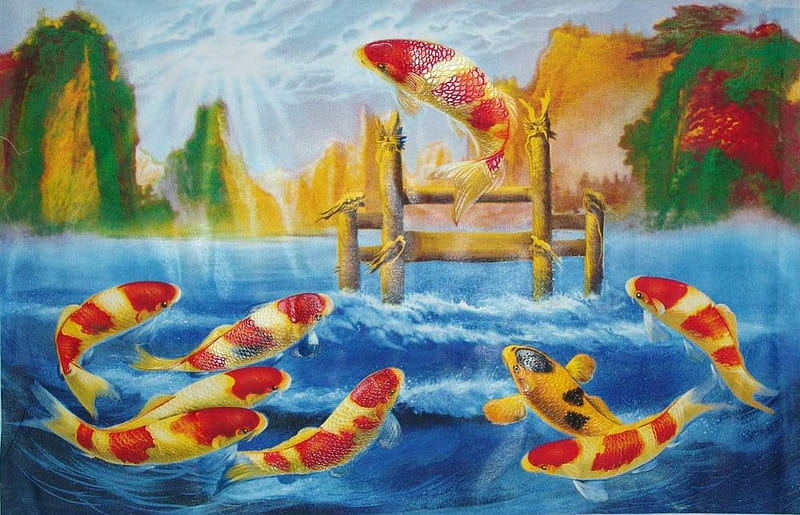Koi Fish Dragon Legend
- Koi Turning Into Dragon
- Koi Fish Dragon Legend Restaurant
- Koi Fish Dragon Tattoos
- Koi Fish Dragon Pictures
- Dragon Koi Fish
Koi fish have intrigued and inspired for centuries. They are rich with symbolic significance especially in Japanese and Chinese culture and history. Known universally as a symbol of strength, perseverance, love, bravery and dedication, enthusiasts collect both the living carp as well as items or art.
What is Koi?
The koi fish is a fresh-water carp commonly bred to celebrate its beautiful colour patterns and scales. The fish is kept in ponds or aquariums as decorative or symbolic reasons.
The word “koi“ is Japanese for carp, used to describe all carps, even the less flashy types with muted colours There are over 120 types of koi today.
Jan 13, 2015 In Japanese, “Koi” means love, another example of how much this strong fish impressed the Japanese nation. While Japanese legends about koi are abound, my personal favorite is, “The Dragon Gate”. The legend goes something like this; There were thousands of koi swimming up the Yellow River in Japan. They swam for a very long time upriver.
What does Koi symbolise?
Sometimes called “living jewels”, the koi fish has become a famous symbol of beauty, love, and prosperity throughout the world.
- The gods recognized the Koi for its perseverance and determination and turned it into a golden dragon, the image of power and strength. Symbolism and Meaning. Koi fish are associated with positive imagery. Because of the dragon legend, they are known as symbols of strength and perseverance, as seen in their determinative struggle upstream.
- Koi Fish Legends. Many of the above described symbolic meanings of koi fish stem from the Chinese legend of the Dragon Gate in which a koi fish swam upstream, through waterfalls and other obstacles to reach the top of the mountain. At the top of the mountain was the 'Dragon Gate.'
Koi is associated with strength and perseverance in many legends, two in which we’ve included below.
The Chinese Koi Fish Waterfall Legend
Legend says that long ago, there was an abundance of golden koi fish in the Yellow River in China. They made their way upstream, going against the current, building strength and perseverance. Their golden hue made the river shimmer as if it was a river of gold.
Halfway upstream, they came to a large waterfall, an impossible height that is too high to traverse. This waterfall is known as the “Dragon’s Gate” in Hunan province. Most of the koi turned back, going with the current to safer ground. However, some koi stayed and attempted to jump and surpass the waterfall. Some of them got halfway, but then pummelled back downstream after they’ve lost momentum and energy.
The spirits of the river watched the koi try over and over again, making fun of them as they found it amusing.
This went on for one hundred years, the group of koi continued to try and swim up the waterfall but always stopped at exactly that waterfall. At each attempt the koi made it slightly further, gaining technique and strength as they practiced that waterfall.
Koi Turning Into Dragon
The spirits continued to make fun of the koi, knowing that it’s such an impossible feat to make it past the waterfall.
One koi tried a different strategy. It went down to the bottom of the river, built up as much speed as it could, and leaped out of the water. It swam as hard as it could up the walls. Somehow, it reached the top of the waterfall, and continued to swim upstream.
The spirits were silenced watching that scene - how the koi succeeded in the impossible. Knowing the multiple attempts that the koi have tried over the years,
The spirits transformed the koi into a golden dragon as a reward for its achievement. In the Chinese culture, a golden dragon is the ultimate symbol of power and strength. That is also how the waterfall is known to be Dragon’s Gate - through this popular fable.

Japanese Koi Fish and Samurai Warriors
In Japanese culture and myth, the koi fish is associated with a few different myths and legends. The most notable is its association with Samurai Warriors. Samurai Warriors are known for their loyalty, strength and bravery. The koi’s migration upstream in rivers through waterfalls is not an easy one, as they swim with such strength and ferocity that they are compared to samurais.
Koi Fish Dragon Legend Restaurant

Interestingly as well, when a koi fish is caught, it does not wriggle and bounce about, instead it stoically stays still. Even as a fisherman’s knife descends on them, the koi stays still - accepting its fate just like how a samurai would in honour.
Lladró’s Koi Fish sculpture
Lladró made a Koi sculpture limited to 2000 pieces, where two Koi fishes swim around a lotus flower. The colourful sculpture is an elegant way to add colour to your decor, a realistic and luxurious representation of “living jewels“.
Koi fish are known to swim in pairs, and are naturally known in many cultures as a symbol of love and affection, just how these two fishes swim side by side in matrimony.
It wasn’t till the early 1800s that the Japanese started to breed for colour, creating the many (up to 70) varieties of koi available today. The two kois are of the popular Kohaku variety and Sanke variety.


A look into Japanese “Koi” or more as they are commonly known as, “River Carp”, will lead you toward a fascinating look into the mythology and character of the Japanese people. Pre 1820’s in Japan carp were the perfect choice of protein in the diet of Japanese people who lived near rivers. Unfortunately many rivers freeze over during the winters and the carp were unavailable. The industrious farmers began to build barrels in their barns where the Carp could be stored during the winters. They only had to go outside to the barn to collect a plump carp for dinner on a winters evening.. The larger the barrel the longer this delight lasted through winter. As the barrels grew the carp, who were well fed and cared for, began to mate. Eventually giving out spawn that were albino or oddly marked.
Magoi or black carp are the most common form same as the carp we find in American rivers. When the Japanese witnessed the odd coloration of these captive carp they began to keep them as pets. Eventually the odd fish were left in the barrels long into spring and began mating with each other. The process became codified and the first known carp coloration bred specifically for it’s color was a “Kohaku” or orange stepped Koi. The body became white and there were three, four or five blotches of orange across the fish from head to tail. These orange patches mimicked the stones found in formal Japanese gardens. Which are placed so that woman in a tight fitting Kimono could easily step from one stone to the next. The peasant farmers began to compare and compete openly with each other on this amazing feat of transforming the lowly carp to something dazzling. Soon catching the eye of the aristocracy of Japan. Who quickly adapted the process and took it out of the hands of the farmers. Breeding for specific colors and patterns has been active since the 1820’s or so creating the current international market for landscape decor and international high dollar competitions for decorative koi. Many new patterns Koi have since been bread and a Japanese champion koi can cost well over $50,000.00 each.
THe mythological version of this simple creature is just as fascinating
HOW KOI BECOME DRAGONS
In the wild, koi are cold fresh water river fish who gain strength by swimming against currents.
Many years ago, in a time before recorded history, a huge school containing thousands of koi swam up the Yellow River. Observers reported the colors of their well muscled bodies flashed in the sunlight making them seem like a million living jewels. All was going well until the koi reached a waterfall. Immediately, a large number of them grew discouraged and turned back, finding it much easier to simply go with the flow of the river. Yet, a determined group of 360 koi stayed on. Straining and leaping, each koi strove to reach the top of the falls. Again and again they flung their bodies into the air only to fall back into the water. All this splashing noise drew the attention of the local demons who laughed at the efforts of the struggling koi. Adding to their misery, the demons sadistically increased the height of the falls. Still the koi refused give up! The koi continued their efforts for one hundred years. At last, with one heroic leap, a single koi reached the top of the falls. The God’s smiled down in approval and transformed the exhausted koi into a SHINING GOLDEN DRAGON- He joyfully spends his days chasing pearls of wisdom across the skies of the vast and eternal heavens.
Whenever another koi finds the strength and courage to leap up the falls, he or she too becomes a heavenly dragon. The falls have become know as the Dragon’s Gate and, because of their endurance and perseverance, koi have become symbolic of overcoming adversity and fulfilling one’s destiny.
Swimming koi became symbolic of worldly aspiration and advancement.
Koi fish are associated with positive imagery. Because of the dragon legend, they are known as symbols of strength and perseverance, as seen in their determinative struggle upstream. And because of the lone koi that made it to the top of the waterfall, they are also known as symbols of a destiny fulfilled. Resulting from its bravery in swimming upstream, the koi is oftentimes associated with Samurai Warriors in Japan. The integrity and high sense of character koi are known for makes them a popular tattoo choice both in Asia as well as America.
The koi is known for its strength, individuality, character, and perseverance.
Koi fish are also symbolized according to their coloration. Black koi represent masculinity. It also signifies a patriarchal role. Gold koi symbolize prosperity and wellbeing in business. Blue koi, often associated with the role of the son, represents tranquility. Red koi represent strength and power. It also is recognized as the matriarchal koi.
Koi Fish Dragon Tattoos

Tattoos of Koi are very popular around the globe and thousands of people who wear them are quite uninformed on their origins, meaning, and symbolism.
I though you might enjoy seeing my three versions of the “DRAGON KOI” all are watercolor renderings. Each is available for sale; as original paintings, digital prints and tattoo commissions!
Koi Fish Dragon Pictures
I hope you enjoyed this post let me know what you think
Dragon Koi Fish
Original Dragon Koi watercolor paintings by Shotsie Gorman